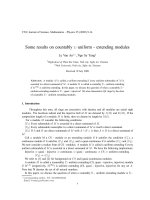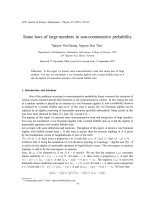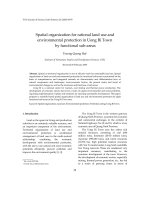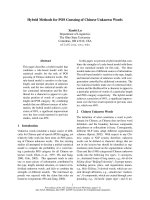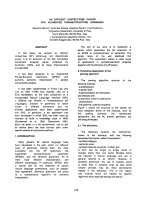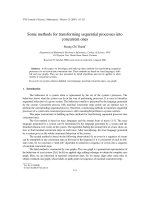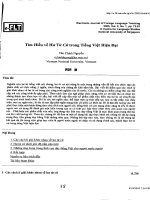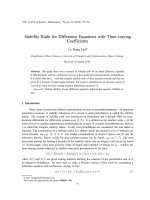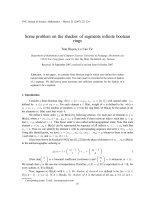Báo cáo " Some methods for transforming sequential processes into concurrent ones " pot
Bạn đang xem bản rút gọn của tài liệu. Xem và tải ngay bản đầy đủ của tài liệu tại đây (125.3 KB, 9 trang )
VNU Journal of Science, Mathematics - Physics 23 (2007) 113-121
113
Some methods for transforming sequential processes into
concurrent ones
Hoang Chi Thanh
*
Department of Mathematic Mechanics Informatics, College of Science, VNU
334 Nguyen Trai, Thanh Xuan, Hanoi, Vietnam
Received 31 October 2006; received in revised form 2 August 2007
Abstract: In this paper we investigate and build up three methods for transforming sequential
processes of a net system into concurrent ones. These methods are based on: trace languages, shift-
left and case graphs. They are also presented by detail algorithms and can be applied to other
models of concurrent systems.
Keywords: net system, reliance alphabet, trace language, maximal concurrent steps, case graph.
1.
Introduction
The behaviour of a system often is represented by the set of the system’s processes. The
behaviour shows what the system can do in the way of performing processes. It is easy to formalize
sequential behaviour of a given system. The behaviour usually is presented by the language generated
by the system. Concurrent process with maximal concurrent steps points out an optimal way to
perform the corresponding sequential process. Therefore, constructing methods to transform sequential
processes of a system into concurrent processes is still a meaningful problem in system controls.
This paper concentrates in building up three methods for transforming sequential processes into
concurrent ones.
The first method is based on trace languages and the normal form of traces [1-3]. The trace
language generated by a system can be determined by the language generated by a system and the
detached relation over events of the system. The algorithm finding the normal form of a trace shows us
how to find maximal concurrent steps on each trace. After normalizing, the trace language generated
by a system gives us the whole concurrent behaviour of the system.
The second method is based on the following observation [4]: an event in a sequence of events
can be attempted on any concurrent step on the head of the sequence if it is concurrent of each its left-
side event. So we construct a “shift-left” algorithm to transform a sequence of events into a sequence
of maximal concurrent steps.
The third method is constructed by case graphs. The case graph is a geometrical representation of
the behaviour of a net system [5,6]. In [6] we applied edge adding technique to obtain the complete case
graph. Here, we are interested in maximal concurrent steps. So we merge edges after some rules to
obtain a reduced case graph, whose labels on paths point out sequences of maximal concurrent steps.
______
*
Tel.: 84-4-5585840
E-mail:
Hoang Chi Thanh / VNU Journal of Science, Mathematics - Physics 23 (2007) 113-121
114
A popular model to represent concurrent systems is a net system. We recall some important
notions.
1.1. Net systems
Based on a simple Petri net, a net system is defined in [2,3,5] as follows.
Definition 1: A triple N = (B, E; F) is called a Petri net iff:
1. B, E are two disjoint sets,
2. F ⊆ (B × E) ∪ (E × B) is a binary relation, the flow relation of N.
Elements of the set B present conditions and elements of the set E present events of the system.
The flow relation F shows the relationship between two these objects.
Let N = (B, E; F) be a net. For x ∈ X
N
= B ∪ E,
•
x = {y (y,x) ∈ F } is called the preset of x,
x
•
= {y (x,y) ∈ F } is called the postset of x.
The net N is called simple iff distinct elements do not have the same pre- and postset.
Each subset c ⊆ B is called a case of the net N.
Let e ∈ E and c ⊆ B. The event e is c-enabled iff
•
e ⊆ c ∧ e
•
∩ c = ∅. Then, c’ = (c \
•
e) ∪ e
•
is
called the follower case of c under e (c’ results from the occurrence of e in the case c) and we write:
c[ e > c’.
The occurrence of events on the net N forms a forward reachability relation r
N
⊆ 2
B
× 2
B
,
defined as follows:
∀ c,
c’ ∈ 2
B
: (c,
c’) ∈ r
N
⇔ ∃ e ∈ E, c[ e > c’.
The reflexive and transitive closure of the forward and backward reachability relation, R
N
= (r
N
∪ r
N
-1
)
*
gives us the reachability relation over the net N. It is an equivalence relation over the 2
B
.
Definition 2: A quadruple Σ = (B, E; F, c
0
) is called a net system iff:
1. N = (B, E, F) is a simple net without isolated elements.
2. c
0
⊆ B is a case (the initial case) of the net N.
The equivalence class C = [c
0
]
R
is called the state space of Σ.
An event e may occur in a case c if and only if the preconditions of e belong to c and the
postconditions of e do not belong to c. When e occurs, the preconditions of e cease to hold and the
postconditions of e begin to hold. After the occurrence of an event, the obtained follower case must
belong to the state space. Other events may be enabled by this case. A system’s state space is the
environment for occurrence of steps on the system. The net system is used to model concurrent
systems, such as communicating systems, operation systems, industrial production systems, concurrent
programs …
Let Σ = (B, E; F, c
0
) be a net system and there are a sequence of cases c
1
, c
2
, … , c
n
, c
n+1
belonging to C and a sequence of events e
1
, e
2
, … , e
n
belonging to E such that: c
i
[ e
i
> c
i+1
, i = 1, 2,
… , n.
Then the sequence:
c
1
[ e
1
> c
2
[ e
2
> c
3
… c
n
[ e
n
> c
n+1
presents a sequential process occurred on the system.
Definition 3: The language generated by Σ is defined as follows:
L(Σ) = {e
1
e
2
e
n
∃ c
1
, c
2
, … , c
n
, c
n+1
∈ C , ∃ e
1
, e
2
, … , e
n
∈ E :
c
i
[ e
i
> c
i+1
, i = 1, 2, … , n}.
Hoang Chi Thanh / VNU Journal of Science, Mathematics - Physics 23 (2007) 113-121
115
The language generated by a net system describes all sequences of events occurred on the
system. It is used to represent the system’s behaviour. But the language shows us only the sequences
of events, which occurr sequentially on the system. So how to detect the system’s behaviour, in which
some events may occurr concurrently? Futhermore, can we result it from the sequential language of
the system?
In the next sections, we build three methods for transforming sequential processes into
concurrent ones.
First of all, we formalize concurrent steps on the net system.
1.2. Concurrent steps on a net system
Let Σ = (B, E; F, c
0
) be a net system.
Definition 4:
1. A relation q ⊆ E × E is called a detached relation iff:
∀ e
1
, e
2
∈ E : (e
1
, e
2
)
∈ q ⇔ e
1
≠ e
2
∧
•
e
1
∩
•
e
2
=
•
e
1
∩ e
2
•
= e
1
•
∩
•
e
2
= e
1
•
∩ e
2
•
= ∅.
2. A subset G ⊆ E is called a detached set iff:
∀ e
1
, e
2
∈ G , e
1
≠ e
2
⇒ (e
1
, e
2
)
∈ q.
3. Let c, c’ be cases and G be a detached set. G is called a step on Σ from c to c’ iff each e ∈ G
is c-enabled and c’ = (c \
•
G) ∪ G
•
.
Then we denote: c[ G > c’.
Of course, the detached relation is symmetrical and irreflexive (sir-relation). If G is a step on
the net system Σ then the events belonging G can occurr concurrently. Therefore, quick determining
concurrent steps on a net system becomes a meaningful problem. Usually, we are interested in, as big
as possible, concurrent steps.
Theorem 1 [4]: Let G be a detached set on a net system Σ and let c, c’ be two cases of Σ. Then:
c [ G > c’ ⇔ (c \ c’ =
•
G) ∧ (c’ \ c = G
•
).
The above theorem can be used to detect concurrent steps on a net system. But the complexity
of the corresponding algorithm will be very high.
2.
Concurrency transformation by trace languages
The theory of traces was originated by A. Marzurkiewicz in [2] as an attempt to provide a good
mathematical description of the behaviour of concurrent systems. The normal form of a trace gives an
optimal way to perform a process represented by the trace. So we apply trace languages to net
systems.
Definition 5: Let A be an alphabet.
1. An independence relation over A is a symmetric and irreflexive binary relation p over A.
∀ a, b ∈ A : (a,b) ∈ p ⇔ (b,a) ∈ p ⇒ a
≠
b.
2. A reliance alphabet is a couple (A, p), where A is an alphabet and p is an independence
relation over A.
Considering adjacent independent symbols in a string to be commuting, one can relate different
strings as follows.
Let A = (A, p) be a reliance alphabet.
Hoang Chi Thanh / VNU Journal of Science, Mathematics - Physics 23 (2007) 113-121
116
1. The relation ∼
p
⊆ A
*
× A
*
is defined as follow: for x, y ∈ A
*
, x ∼
p
y iff there exist x
1
, x
2
∈ A
*
and (a,b) ∈ p such that x = x
1
abx
2
and y = x
1
bax
2
.
2. The relation ≈
p
⊆ A
*
× A
*
is defined as the least equivalence relation over A
*
containing ∼
p
.
The relation ≈
p
is indeed the reflexive and transitive closure of ∼
p
.
Thus, ∼
p
identifies ‘commutatively similar’ strings – each such group of strings is called a trace.
Definition 6: Let A = (A, p) be a reliance alphabet.
1. For an x ∈ A
*
, the trace of x, denoted by [x]
p
, is the equivalence class of ≈
p
containing x.
2. A set of traces over A is called a trace language over A.
For traces t
1
, t
2
over A, the trace composition of t
1
and t
2
, denoted by t
1
.t
2
, is defined by t
1
⋅
t
2
=
[x
1
.x
2
]
p
, where x
1
, x
2
∈ A
*
are representatives of t
1
and t
2
respectively.
In general, a trace can be obtained as a trace composition of other traces, but trace
decompositions of the given trace do not have to be unique. Hence it is desirable to have ‘normal
form’ decomposition of traces.
Definition 7: Let A = (A, p) be a reliance alphabet and let t be a trace over A. The following
decomposition t = t
1
.t
2
. … t
m
, such that:
1. for all 1 ≤ i ≤ m, t
i
≠ Λ;
2. for all 1 ≤ i ≤ m, t
i
can be written as [u
i
]
p
, where u
i
∈ A
*
, #
a
(u
i
) = 1 for each a ∈ alph(u
i
), and
(a,b) ∈ p for all a, b ∈ alph(u
i
) such that a
≠
b;
3. for all 1 ≤ i ≤ m-1, if t
i
= [u
i
]
p
and t
i+1
= [u
i+1
]
p
then, for each a ∈ alph(u
i+1
), there exists b ∈
alph(u
i
), such that (a,b) ∉ p;
is called the normal form of the trace t.
In [1] J. I. Aalbersberg and G. Rozenberg pointed out that every trace can be uniquely
decomposed into a normal form, i.e. a minimal number of ‘maximal independent’ parts. They have
built two algorithms for finding the normal form of a trace. The first algorithm is based on integer
pointers and the second one is based on dependence graphs. We recall the first one.
Algorithm 2 [1]:
Input: A reliance alphabet A = (A, p) and a string w ∈ A
*
.
Declaration: Let l = |w| , n = #A and A = {a
1
, a
2
, …, a
n
}; let k be a variable over {0, 1, …, l}
and let d be an array of length n over {1, 2, …, l+1}; let i, j be variables over {1, 2, …, n}; let u be an
array of length l over (A ∪ {λ})
*
; let m be a variable over {1, 2, …, l}.
Computation:
1. For all i = 1, 2, …, n, d(i) := 1
2. For all k = 1, 2, …, l, u(k) := λ
3. k := 0
4. k := k + 1
5. set j such that w(k) = a
j
6. u(d(j)) := u(d(j))a
j
7. For all i = 1, 2, …, n such that i
≠
j , d(i) ≤ d(j) and (a
i
, a
)
) ∉ p, d(i) := d(j)+1
8. d(j) := d(j) + 1
9. if k < l then goto 4)
10. set m such that u(m) ≠ λ and either u(m+1) = λ or m = l
11. stop.
Output: The strings u(1), u(2), , u(m).
Each w ∈ A
*
gives the corresponding trace t = [w]
p
, applying the above algorithm we obtain the
normal form of t = [u(1)]
p
.[u(2)]
p
[u(m)]
p
, where the steps
)(iu
are maximal independent.
Hoang Chi Thanh / VNU Journal of Science, Mathematics - Physics 23 (2007) 113-121
117
Example 8: Let A = (A, p) be the reliance alphabet given by the following undirected graph.
a b c d
e
Let w = aecbbed. Computing by the algorithm 2, we obtain u(1) = ab, u(2) = bce, u(3) = de.
This means the normal form of the trace t = [w]
p
is [ab]
p
.[bce]
p
.[de]
p
. So, instead of performing the
sequential process in 7 steps, one can perform it concurrently in 3 steps.
Now we apply the above technique to net systems. Let Σ = (B, E; F, c
0
) be a net system. The
reliance alphabet defined on the net system is E = (E, q), where E is the set of events and q is the
detached relation over E. Then, the trace language V(Σ) = L(Σ) / ≈
q
represents all concurrent processes
of the net system.
Using the algorithm 2 to find normal form for each trace, we get concurrent processes with
maximal concurrent steps on the given net system.
Note that the input of the algorithm 2 is a representative of the trace. Hence, the algorithm 2
transforms directly strings of the language L(Σ) into the set of normal forms of traces. This is just the
set of all sequences of maximal concurrent steps on Σ.
Example 8: Consider the net system Σ given by the following directed graph.
The set of events E = {e
1
, e
2
, e
3
, e
4
} and the detached relation q = {(e
1
,e
4
), (e
2
,e
3
)}. The
language generated by Σ is L(Σ) = {e
1
e
2
e
3
e
4
, e
1
e
3
e
2
e
4
}. It is just the trace language V(Σ) generated by
the net system Σ.
Applying the algorithm 2 to strings of L(Σ) we get the sequence of maximal concurrent steps
{e
1
},{e
2
,e
3
},{
e
4
}. Thus, events e
2
and
e
3
may be performed concurrently.
In this technique, we recognize that the cases c
i
were hidden. But the following result ensures
the finding normal form of the trace t on the net system is correct.
Hoang Chi Thanh / VNU Journal of Science, Mathematics - Physics 23 (2007) 113-121
118
Theorem 3: Let c
1
[ e
1
> c
2
[ e
2
> c
3
…c
i
[ e
i
> c
i+1
[ e
i+1
> c
i+2
c
n
[ e
n
> c
n+1
be a sequence of
activities on a net system Σ. If (e
i
, e
i+1
) ∈ q then e
i+1
is c
i
-enabled. In other words, c
i
[{e
i
, e
i+1
}
> c
i+2
and {e
i
, e
i+1
} becomes a concurrent step on Σ.
Proof: By the definition of the reachability, c
i+1
= (c
i
\
•
e
i
) ∪ e
i
•
.
Furthermore, c
i+1
enables e
i+1
then
•
e
i+1
⊆ c
i+1
∧ e
i+1
•
∩ c
i+1
= ∅. So,
•
e
i+1
⊆ ((c
i
\
•
e
i
) ∪ e
i
•
) ∧ e
i+1
•
∩ ((c
i
\
•
e
i
) ∪ e
i
•
) = ∅. Because e
i
and e
i+1
are detached then
•
e
i+1
⊆ c
i
∧ e
i+1
•
∩ c
i
= ∅. Thus e
i+1
is c
i
-
enabled and {e
i
, e
i+1
} is a concurrent step on the net system Σ.
The complexity of the algorithm: The transformation is executed on strings of the language
generated by a net system Σ. The length of each string (or its cycle) belonging to L(Σ) is not greater
than |C|. So, by [1] the complexity is
O
(|E|.|C|).
Each case can enable at most |E| events. Thus, the language generated by Σ consists of at most
|E|
|C|
strings. Then the total complexity of the above algorithm is
O
(|C|.|E|
|C|+1
).
3.
“Shift-left” algorithm
Let c
1
[ G
1
> c
2
[ G
2
> c
3
… c
i
[ G
i
> c
i+1
[ G
i+1
> c
i+2
c
n
[ G
n
> c
n+1
be a concurrent process of
the net system Σ.
If there are some events belonging to G
i+1
, when adding them to the previous step G
i
, the
obtained set is still detached and is c
i
-enabled, then we shift these events from the step G
i+1
into the
step G
i
and change the case c
i+1
appropriately. After shifting, if the step G
i+1
becomes empty then we
ignore both c
i+1
and G
i+1
. Repeat this until no event can be shifted.
When the algorithm terminates we get a sequence of maximal concurrent steps of the given net
system Σ.
The input of the algorithm is a sequence of single events. This sequence may be considered as a
sequence of concurrent steps, where each step consists of only one event.
Algorithm 4 (“Shift-left” algorithm):
Input: A sequence of activities c
1
[e
1
> c
2
[e
2
> c
3
c
n
[e
n
> c
n+1
on the net system Σ.
Computation:
1. for i := 1 to n do G
i
:= {e
i
} ;
2. for j := 1 to n-1 do
3. begin
4. i := j ;
5. while i ≥ 1 do
6. begin
7. for every event e ∈ G
i+1
do
8. if G
i
∪{e} is detached ∧ c
i
enables (G
i
∪{e}) then
9. begin
10. c
i+1
:= (c
i+1
\
•
e) ∪ e
•
;
11. G
i
:= G
i
∪ {e} , G
i+1
:= G
i+1
\ {e}; {shift the event e from G
i+1
into G
i
}
12. if G
i+1
= ∅ then ignore both c
i+1
and G
i+1
;
13. end ;
14. i := i - 1
15. end ;
16. end .
Output: A sequence of maximal concurrent steps on Σ.
Hoang Chi Thanh / VNU Journal of Science, Mathematics - Physics 23 (2007) 113-121
119
The algorithm goes back because we want not only making steps maximal concurrent but also
reducing the number of steps.
The algorithm’s complexity: The algorithm transforms a sequential process into a concurrent
one with the complexity of
O
(|C|
2
).
Therefore, the total complexity of the algorithm is
O
(|C|
2
.|E|
|C|
).
Example 9: Applying the “shift-left” algorithm to the net system given in Example 8, we get the
following sequence of maximal concurrent steps {e
1
},{e
2
,
e
3
},{
e
4
}.
4.
Reducing case graphs
To view broadly all processes happened on a net system we costruct a case graph of the
system. It is a directed graph, whose nodes are cases of the net system and labels on edges describe the
occurrence of events on the net system.
Definition 10: Let Σ be a net system. Construct the following set of labelled edges.
P = { (c, e , c’) ∈ C
× E × C
c
[ e > c’ }
Labelled directed graph Φ = (C, P) is called a case graph of the net system Σ.
In the case graph Φ, each edge (c, e , c’) can be considered as the edge (c, G , c’) with the
single step G = {e}. Therefore, the labels on edges are steps. In order to find maximal concurrent steps
on Σ, we reduce the case graph of the net system. The reducing is based on the following results.
Theorem 5: Let Σ be a net system and let c
1
, c
2
, c
3
∈ C ; G
1
, G
2
⊆ E.
If (c
1
, G
1
, c
2
) and (c
1
, G
2
, c
3
) are two edges of the case graph Φ, G
1
∩ G
2
= ∅ then (c
2
, G
2
, c
4
)
and (c
3
, G
1
, c
4
) with c
4
= (c
1
\
•
G) ∪ G
•
are just two edges of the graph Φ and if G = G
1
∪ G
2
is
detached then c
1
[ G
2
> c
4
.
Proof:
Since c
1
[ G
1
> c
2
then
•
G
1
⊆ c
1
, G
1
•
∩ c
1
= ∅ and c
2
= (c
1
\
•
G
1
) ∪ G
1
•
.
Similarly, since c
1
[ G
2
> c
3
then
•
G
2
⊆ c
1
, G
2
•
∩ c
1
= ∅ and c
3
= (c
1
\
•
G
2
) ∪ G
2
•
. Futher,
because G
1
, G
2
are detached and G
1
∩ G
2
= ∅ then we have
•
G
2
⊆ c
2
and G
2
•
∩ c
2
= ∅. Thus c
2
[
G
2
> c
4
with c
4
= (c
1
\
•
G) ∪ G
•
. Analogously, we prove that c
3
[ G
1
> c
4
.
Because the set G is detached then c
1
[ G > c
4
.
Theorem 6: Let Σ be a net system and let c
1
, c
2
, c
3
∈ C ; G
1
, G
2
⊆ E.
If (c
1
, G
1
, c
2
) and (c
2
, G
2
, c
3
) are two edges on the case graph Φ then G
1
∩ G
2
= ∅ and (c
1
, G
2
,
c
4
), (c
4
, G
1
, c
3
) with c
4
= (c
1
\
•
G) ∪ G
•
are two edges of the graph Φ and if the set G = G
1
∪ G
2
is
detached then c
1
[ G > c
3
.
Proof:
Assume that e ∈ G
1
. Thus
•
e ∩ c
2
= ∅. So e is not c
2
-enabled. It means e ∉ G
2
. We have G
1
∩
G
2
= ∅.
Since
•
G
1
⊆ c
1
and
•
G
2
⊆ c
1
we get
•
G
1
∪
•
G
2
⊆ c
1
. Futher, because G = G
1
∪ G
2
is detached then
•
G =
•
G
1
∪
•
G
2
⊆ c
1
. Analogously, because G
1
•
∩ c
1
= ∅ , G
2
•
∩ c
1
= ∅ we have (G
1
•
∪ G
2
•
) ∩ c
1
= ∅.
Hence G
2
is c
1
-enabled and we get c
1
[ G
2
> c
4
with c
4
= (c
1
\
•
G
2
) ∪ G
2
•
and c
4
[ G
1
> c
3
. Since
G = G
1
∪ G
2
is detached then G
•
= G
1
•
∪ G
2
•
. We have G
•
∩ c
1
= ∅. It means c
1
[G > c
3
.
Using Theorem 5 and Theorem 6 above, we build an algorithm to reduce case graphs as
follows.
Hoang Chi Thanh / VNU Journal of Science, Mathematics - Physics 23 (2007) 113-121
120
Algorithm 7: Construct the case graph Φ = (C, P) of the net system Σ, whose label on each edge
is a single step.
If (c
1
, G
1
, c
2
) and (c
1
, G
2
, c
3
) are two edges of the graph, G
1
∩ G
2
= ∅ and G = G
1
∪ G
2
is
detached then we remove 4 edges (c
1
, G
1
, c
2
), (c
1
, G
2
, c
3
), (c
2
, G
2
, c
4
) and (c
3
, G
1
, c
4
) with c
4
= (c
1
\
•
G)
∪ G
•
and add a new edge (c
1
, G, c
4
).
If (c
1
, G
1
, c
2
) and (c
2
, G
2
, c
3
) are two edges of the case graph and G = G
1
∪ G
2
is detached then
we remove 4 edges (c
1
, G
1
, c
2
), (c
2
, G
2
, c
3
), (c
1
, G
2
, c
4
) and (c
4
, G
1
, c
3
) with c
4
= (c
1
\
•
G
2
) ∪ G
2
•
and
add a new edge (c
1
, G, c
3
).
Repeat the instructions 2) and 3) until no edges can be removed.
Note that, in the instruction 2) we have to check whether the sets G
1
and G
2
are disjoint, but it is
no need for the instruction 3).
Sequences of labels on paths of the reduced case graph point out concurrent processes of the
net system Σ with maximal concurrent steps.
The algorithm’s complexity: We can use a searching algorithm (breadth-first search or depth-
first search) on the case graph to detect situations as in the instructions 2) and 3). The case graph
consists of |C| nodes and the degree of each node is not greater than |E|. Thus the complexity of the
graph searching is
O
(|C|.(|E|+1)). The times of searching are not grater than |E|. At every node, one
has to choose two its adjacent edges and check the disjoint of their labels and the detachment of the
union of these labels.
Therefore, the total complexity of the algorithm is
O
(|C|.|E|
4
).
Example 11: Consider the net system Σ given in Example 8. The case graph and the reduced
case graph of the net system are the following.
a) The case graph
b) The reduced case graph
From the reduced case graph of the net system ∑ we get the sequence of labels on a path.
It is just the sequence of maximal concurrent steps {e
1
},{e
2
,
e
3
},{
e
4
}.
5.
Conclusion
Determination of concurrent steps, maximal concurrent steps on distributed systems still is an
open problem. Three methods above presented for transforming sequential processes into concurrent
Hoang Chi Thanh / VNU Journal of Science, Mathematics - Physics 23 (2007) 113-121
121
ones can be applied in system controls. Two first methods begin from the language generated by the
given system and use an algorithm to find the normal form of traces or the “shift-left” algorithm.
These algorithms have the same complexity, but the second one is much simpler. The complexity of
the third algorithm is the least. It is more complicated when computing on computers.
These methods can be applied to other models of distributed systems, especially to models with
dynamic environment or timed changing.
Acknowledgements. This paper is based on the talk given at the Conference on Mathematics,
Mechanics, and Informatics, Hanoi, 7/10/2006, on the occasion of 50th Anniversary of Department of
Mathematics, Mechanics and Informatics, Vietnam National University.
References
[1]
J.I. Aalbersbeg, G. Rozenberg, Theory of Traces, Theoretical Computer Science 60 (1988) 1.
[2]
A. Mazurkiewicz, Concurrent program schemes and their interpretations, DAIMI Report PB-78, Aarhus Univ.,
Denmark, 1977.
[3]
Hoang Chi Thanh, Behavioural Synchronization of Net Systems, IMSc Report 115, Madras, India (1991) 136.
[4]
Hoang Chi Thanh, “Shift-left” Algorithms Transforming Sequential Processes into Concurrent Ones, Proceedings of the
Second National Symposium “Fundamental and Applied Information Technology Research (FAIR), Science &
Technique Press, 2006.
[5]
W. Reisig, Petri Nets: An Introduction, Springer-Verlag, 1985.
[6]
Hoang Chi Thanh, Vu Trong Que, Using case graphs in concurrency control on net systems Proceedings of the 9
th
National Symposium on Information Technology and Communication, ), Science & Technique Press, 2007.
